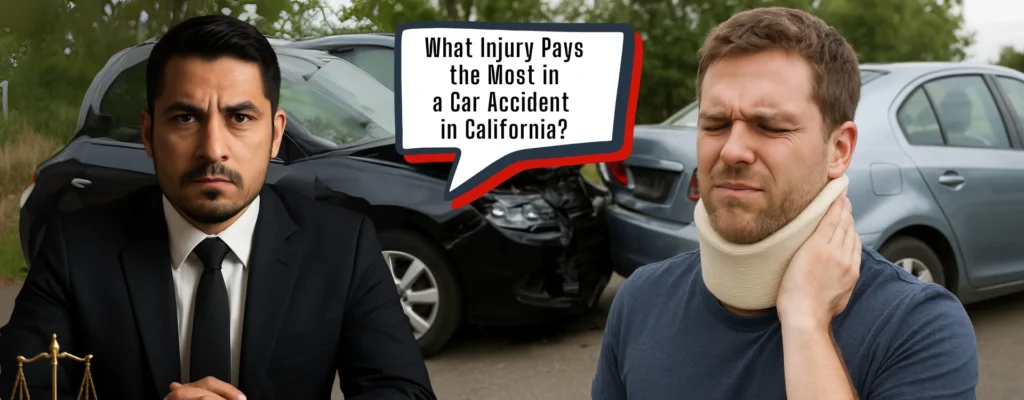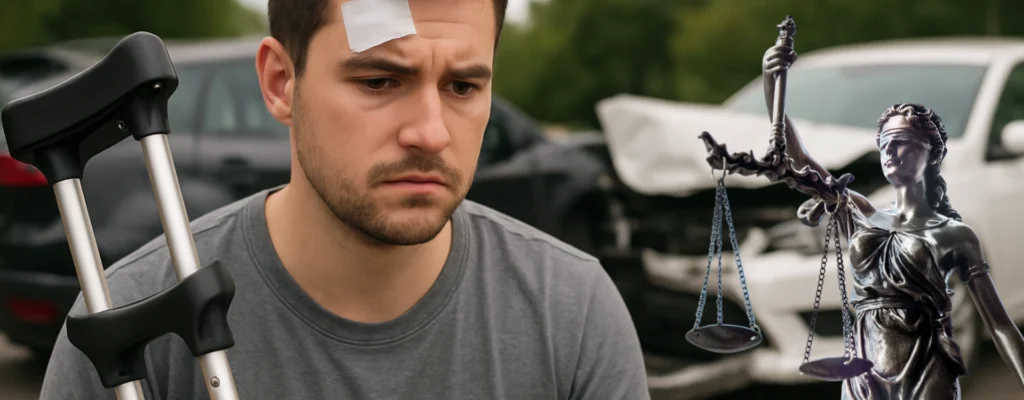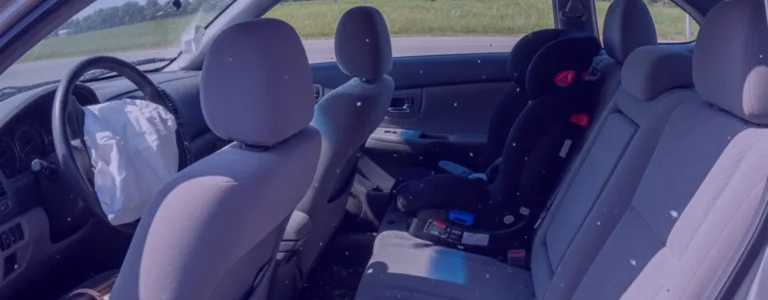What Injury Pays the Most in a Car Accident in California?

You want to know which injuries lead to the largest settlements or verdicts. California law pays for the full impact of your harm — medical care, lost income, future care, and human losses like pain, suffering, and disfigurement. In real cases, the highest payouts usually come from injuries that cause permanent disability, long-term treatment, or a lifelong change in how you live and work.
Do you need compassionate support and effective representation?
No fees until we win. Available 24/7.
What Drives a High Payout in California?
What injury pays the most in a car crash? You maximize value when you prove how the crash changed your life, your work, and your future costs. California pays for both economic and non-economic damages, and you can present evidence for each category. Keep these drivers in mind:
Severity and permanence
Injuries that cause paralysis, cognitive impairment, or major scarring command the highest damages because they change your independence, earnings, and daily function. Authoritative public data show that the most serious crash outcomes remain a major national and state problem, even as overall fatalities declined in 2023.
Medical and life-care needs
Long hospital stays, multiple surgeries, prosthetics, home and vehicle modifications, in-home attendants, and therapy increase economic damages. National injury-cost dashboards confirm that inpatient injuries drive far higher medical and work-loss costs than treat-and-release cases.
Work impact and earning capacity
If you cannot return to your job, or you must switch to lower-paid work, your claim value rises. California and federal health-care utilization data help quantify these losses.
Proof
Strong evidence — medical records, specialist opinions, and crash data — moves insurers and juries. California’s statewide crash systems, including the California Crash Reporting System (CCRS) and SWITRS via UC Berkeley’s TIMS, supply official data that supports case investigations.
Important claim note: California does not require a police report to open an insurance claim. Insurers can, and often do, start claims without one, though a report can make things smoother.
Injuries That Usually Lead to the Biggest Compensation
You see the highest California car-crash payouts when the injury brings permanent limitations, long recoveries, and high lifetime costs. Here are the categories that most often lead settlements and verdicts from a car accident in California.
Spinal cord injuries (paraplegia or tetraplegia)
These injuries can cause permanent loss of movement or sensation, bowel and bladder issues, sexual dysfunction, and autonomic problems. They often require full life-care plans, adaptive equipment, and architectural changes at home, which push economic damages, and they dramatically increase non-economic damages. The National Institute of Neurological Disorders and Stroke (NINDS) explains the breadth and permanence of spinal cord injury deficits.
Moderate to severe traumatic brain injuries (TBI)
TBIs affect memory, attention, mood, and impulse control; they strain families, treatment teams, and employment. CDC data show TBI remains a major cause of death and disability, with extensive public resources tracking its long-term impact. These cases frequently include neuropsychological testing, cognitive rehab, and vocational losses that elevate both economic and non-economic damages.
Severe burns and disfigurement
Grafting, infection risk, contractures, chronic pain, and repeated surgeries increase costs. Visible scarring raises non-economic damages for disfigurement and emotional distress. Federal burn-model program resources underscore the long-term care and research focus for serious burns.
Amputations and complex orthopedic trauma
Limb loss, crush injuries, and multi-fracture cases require staged surgeries, prosthetics, and long rehabilitation. Hospital utilization and cost tools from AHRQ (Agency for Healthcare Research and Quality) help illustrate the magnitude of inpatient care and long-run expenses that flow into damage models.
What Injury Pays the Most? Medical Proof That Protects Value

You strengthen your claim when your doctors document the full picture, not just today’s symptoms. An important aspect of what doctors should check after a car accident is the assessment of past injuries that may have been worsened by the incident. Medical professionals should carefully evaluate any pre-existing conditions.
When fault becomes a fight, specialists can solidify liability. Accident reconstruction experts analyze scene evidence, vehicle damage, and road conditions. They also read the vehicles’ Event Data Recorders (EDRs), which capture speed, braking, and steering inputs that show how the crash unfolded.
California Snapshot You Can Use in Negotiations
You negotiate better when you ground your demand in current public data. The National Highway Traffic Safety Administration reported 40,901 U.S. traffic deaths in 2023, a 4.3% decrease from 2022, but still an unacceptably high number that reflects severe injury risk on the roads.
California’s Office of Traffic Safety shows statewide trends like an 8.8% drop in pedestrian fatalities from 2022 to 2023, while reminding us that serious injury categories remain high-impact for families and communities. Use these authoritative figures to frame why full compensation matters in a case involving a car accident in California.
Practical Steps That Raise the Value of a Serious-Injury Claim
You improve outcomes when you treat the claim like a project with deadlines, records, and expert help.
- Get immediate, consistent care, and follow through. Fill prescriptions, attend therapy, and keep a symptom journal. Cost-of-injury tools from CDC show why complete treatment records matter when you prove economic losses.
- Tell providers about prior injuries, and ask them to document aggravation. That documentation ties the crash to your worsened condition and supports damages. (See RTM Law guidance linked above.)
- Preserve evidence. Photograph injuries, save damaged items, and request that your vehicle and its EDR data remain available for inspection by qualified experts. (See RTM Law accident reconstruction resource.)
- Report the crash to your insurer quickly, even without a police report. You can still open a claim in California without one, and you should request the report if an officer wrote it to streamline fault decisions.
- Use credible public data to support your demand. Point adjusters to current NHTSA, OTS, CDC, and AHRQ resources that show severity, costs, and trends.
Why “the Biggest-Paying Injury” Isn’t a Single Label
You increase your recovery by proving your specific losses, not by chasing a label. Two people with the same diagnosis can have very different outcomes because of age, job demands, access to treatment, family support, and pre-existing conditions.
California data systems (CCRS and SWITRS via UC Berkeley’s TIMS) and national sources (NHTSA, CDC, AHRQ) help your team show the scale of harm and the reasonableness of your life-care plan and wage-loss model.
Your Next Best Move
Prioritize your health, lock down evidence, and put experts to work early. When your injuries involve the spinal cord, the brain, severe burns, or limb loss, you likely face high lifetime costs, serious work limitations, and significant human losses — exactly the kind of proof California juries and insurers compensate at the highest levels.
Start treatment, keep clean records, and ask a California car-accident lawyer to build the medical and technical evidence that makes your damages clear, compelling, and complete.
Victim of a crash in California? Talk to RTM Law for a free, confidential consultation today. We take calls 24/7, and we charge no fee unless we win for you.
Do you need compassionate support and effective representation?
No fees until we win. Available 24/7.




